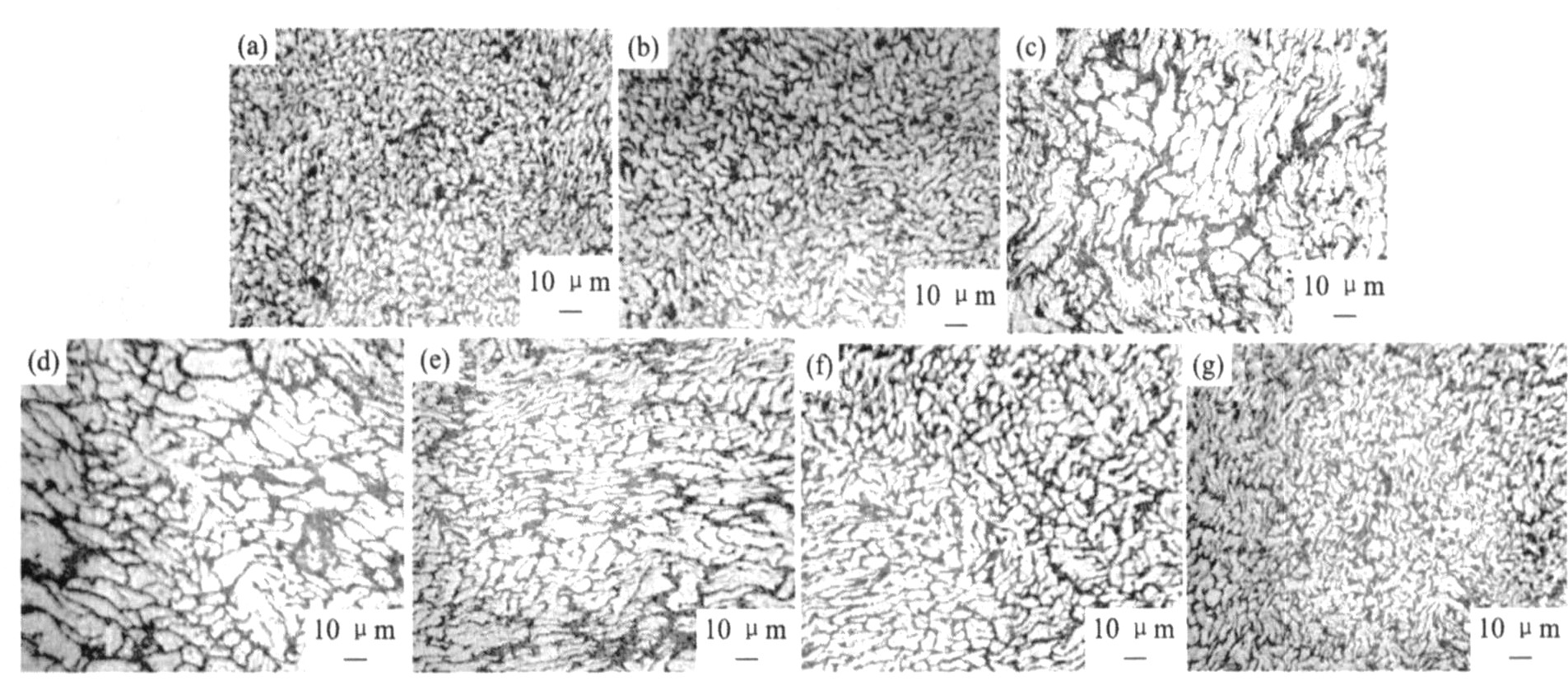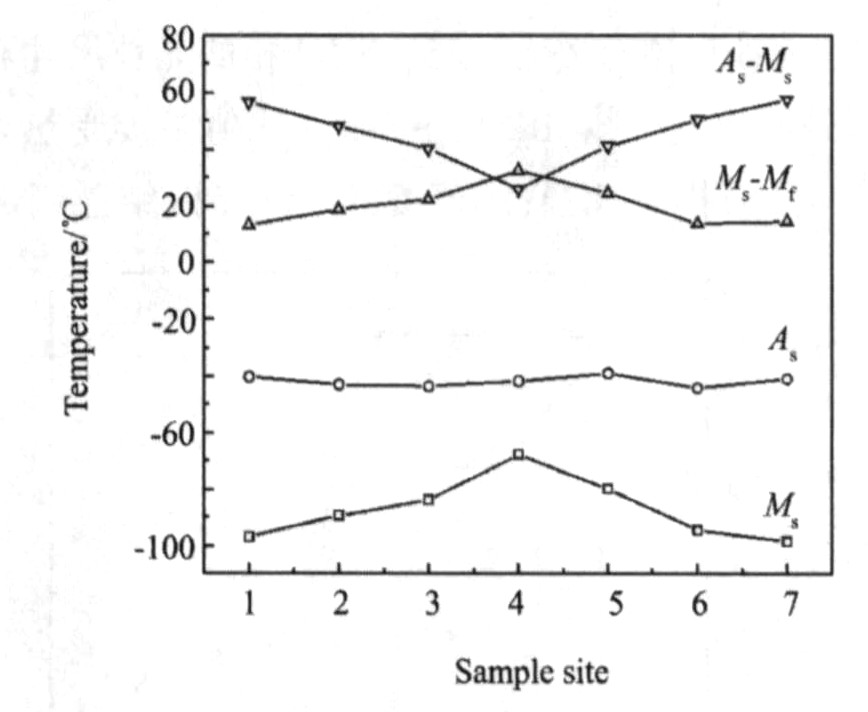再结晶对Ni47Ti44Nb9形状记忆合金棒相变和织构的影响
东北大学材料物理与化学研究所
中国科学院金属研究所
摘 要:
利用光学显微镜 (OM) , DSC和XRD, 研究了直径19 mm Ni47Ti44Nb9热轧棒材再结晶对相变和织构的影响, 为该合金棒的实际应用提供理论依据。结果表明:热轧棒从450℃开始发生明显再结晶;从850℃/90 min真空退火棒材的中心到边缘, 再结晶晶粒尺寸减小, Ms降低, 马氏体转变区间变窄, 热滞增大;热轧棒中形成了较强的γ丝织构, 600℃/90 min退火后, γ丝织构强度稍有下降, 退火温度升到850℃, 丝织构明显减弱, 等密度线发生漫散, 形成了新的织构组分, 这有利于改善棒材径向方向的恢复应变。
关键词:
形状记忆合金;再结晶;织构;相变;Ni47Ti44Nb9棒;
中图分类号: TG146.4
收稿日期:2007-09-29
基金:核燃料及材料国防科技重点实验室基金资助项目 (51481130101ZK0601);
Influence of Recrystallization on Phase Transformation and Texture of Ni47Ti44Nb9 Shape Memory Alloy Bar
Abstract:
The influences of recrystallization on phase transformation and texture of as-hot-rolled Ni47Ti44Nb9 alloy bar with a diameter of 19 mm were systematically investigated using optical microscope (OM) , differential scanning calorimetry (DSC) and X-ray diffraction (XRD) to provide theoretical basis for application of the alloy bar.The results showed that the recrystallization of the hot-rolled bar started obviously at 450 ℃, and recrystallized grain size was decreased and Ms dropped.Temperature ranges of martensitic transformation became narrower and thermal hystereses increased from the center to the edge of the bar vacuum annealed at 850 ℃/90 min F.C.More intensive γ fibre texture was formed in the as-hot-rolled bar.But intensity of γ fibre texture in the bar annealed at 600 ℃/90 min F.C was slightly decreased.When annealing temperature was 850 ℃, γ fibre texture was markedly weakened, the diffusion of the isopycnals occurred, and new texture components were formed, which was beneficial to improving restoration strain of the bar along radial direction.
Keyword:
shape memory alloy;recrystallization;texture;phase transformation;Ni47Ti44Nb9 bar;
Received: 2007-09-29
NiTiNb形状记忆合金因具有宽的相变滞后和良好的记忆功能在工程上应用前景广阔。 TiNi基合金相变温度主要取决于B2相中的Ni/Ti比值, 比值越低, Ms和As越高, 相变热滞越小
形状记忆合金在热加工过程中形成的织构会影响记忆应变。 目前TiNi形状记忆合金织构的研究较多, 如TiNi合金的丝材或棒材, 具有〈111〉织构时可获得较高的恢复应变
热轧NiTiNb合金棒主要是用来生产液压管路连接的管接头或紧固件, 希望具有较大的热滞和沿径向较高的恢复应变。 因此, 研究再结晶对棒材最终织构和转变行为的影响非常重要。 本文通过热锻加热轧制备出Ni47Ti44Nb9合金棒材, 利用光学显微镜 (OM) , DSC和XRD研究热轧棒再结晶对相变和织构的影响, 为该合金棒的实际应用提供理论依据。
1 实 验
真空感应炉熔炼出直径120 mm的Ni47Ti44Nb9 (原子分数) 合金铸锭, 铸锭经900 ℃/3 h均匀化处理后, 在850 ℃, 一端固定, 另一端呈自由状态, 周向旋转的8个锤头锤击锻成直径65 mm的棒材, 接着在850 ℃再热轧成直径19 mm。
硬度测试和金相观察样品经350~850 ℃/90 min淬火 (W.C.) 处理; 在棒材边缘沿轴向切一条浅的细缝, 之后垂直轴向切厚2.5 mm织构样品, 样品经600, 850 ℃/90 min退火 (F.C.) , 规定垂直棒材轴向的平面为轧制面 (HKL) , 样品中心到细缝方向作为轧制方向[UVW]; DSC样品是从图1所示的1~7号长宽为10 mm×7 mm、 厚2 mm的片状样品上切下的, 其尺寸为直径3 mm, 厚1 mm, 所有DSC样品中心分布在垂直于片状试样的长×宽平面的同一直径线上。
图1 片状样品切割位置示意图
Fig.1 Cutting schematic diagram of plate samples
(DSC sample are cut from 1 to 7 plate samples whose sizes are 10mm×7 mm×2 mm;10 and 17 mm are the length and height of cuboid sample, respectively)
图2 热轧棒在不同条件下距中心 (1/3~2/3) R处且垂直轴向截面的金相组织
Fig.2 OM microstructures of the sample sections normal to axis direction of the as-hot-rolled bar at (1/3~2/3) R sites and under different conditions
(a) Barhot-rolled at850℃, Ais dentritic B2 matrix, B the eutectic of B2 andβ-Nb distributing between B2 phases, C broken B2 dentrite; (b) 450℃/90 min W.C., D are local recrystallized zones; (c) 600℃/90 minW.C, more and more fine grain zones formed by recrystallization; (d) 850℃/90 min W.C.
在450SVDTM维氏硬度计上测试硬度, 加49 N力, 作用15 s; 利用Pyris Diamond DSC仪测相转变温度, 温度循环范围: 30 ℃→-160 ℃→30 ℃, 升/降速率为20 ℃·min-1; 织构在X′pert Pro MRD X射线衍射仪上测定, 实验采用Co Kα辐射, 管压35 kV, 管流40 mA。 测定B2基体相{110}, {200}, {211} 3个不完整极图。 极图测量范围α=0~70°, β=0~360°, 利用Roe法计算取向分布函数 (ODF) 。
2 结果和讨论
2.1 合金棒再结晶
为研究再结晶对热轧Ni47Ti44Nb9合金棒相变和织构的影响, 先通过金相观察和硬度测试确定热轧棒再结晶开始温度。 一般用棒材加工管接头或紧固件是取棒材的 (1/3~2/3) R位置 (R为棒材半径) , 所以组织观察和硬度测试选在棒材的 (1/3~2/3) R处。
图2显示了不同淬火温度、 保温90 min试样垂直棒材轴向截面的金相组织。 该合金的显微组织由树枝状的B2基体相和树枝晶之间的 (B2+β-Nb) 共晶体组成, 有些树枝晶已破碎, 但呈现区域流线走向非常明显 (图2 (a) ) 。 当温度升到450 ℃时, 可观察到明显的再结晶区域 (图2 (b) ) , 这表明此时在距中心 (1/3~2/3) R处已发生再结晶。 随温度继续升高, 发生再结晶形成细小等轴晶区域逐渐增多, 组织中呈现区域流线走向的特征基本消失 (图2 (c) , (d) ) 。
图3显示了不同淬火温度、 保温90 min的棒材在距中心 (1/3~2/3) R处的硬度。 可见, 当热处理温度为350 ℃时, 硬度与热轧态基本一致。 随热处理温度升高, 合金棒硬度缓慢下降, 当温度达到400 ℃后, 硬度值急剧下降, 继续升高温度, 硬度变化不大。
因此, 热轧棒在距中心 (1/3~2/3) R处明显发生再结晶的开始温度约为450 ℃。
2.2 热轧棒的相变和织构
2.2.1 相变
TiNi基合金的相变点除与B2相中的Ni/Ti比值有关
图3 热轧棒距中心 (1/3~2/3) R处HV硬度与淬火温度的关系
Fig.3 Variations of HV hardness at the (1/3~2/3) R sites of hot-rolled bar with quenching temperature
图4 850 ℃/90 min真空退火后, 热轧棒从边缘到中心垂直轴向截面的金相组织
Fig.4 Microstructures of sections normal to axis direction of the hot-rolled bar at 850 ℃/90 min F.C. from the edge to center of bar
(a) and (g) Fine recrystallized grains at the edge of bar; (b) and (f) Finer grains close to edge; (c) and (e) Greater grains near the center of bar; (d) Grains with greater size difference at the center of bar
图5 850 ℃/90 min真空退火后, 从棒材边缘到中心Ms, As, 热滞 (As-Ms) 和马氏体转变区间 (Ms-Mf) 的变化
Fig.5 Variations of Ms, As, thermal hysteresis (As-Ms) and martensitic transformation temperature range (Ms-Mf) from edge to the center of bar annealed at 850 ℃/90 min F.C.
2.2.2 织构
图6显示了热轧棒和不同退火温度下晶粒取向分布函数 (ODF) 恒φ截面图。 从图6 (a) 的φ=45°截面图上可见, 热轧棒中形成了较强的γ丝织构, 即{111}〈UVW〉, 最大极密度值为9.944。 由于在XRD测量过程中, 规定垂直棒材轴向的平面为{HKL}, 径向方向为〈UVW〉, 所以热轧棒中多数晶粒的〈111〉取向平行棒材的轴向。 600 ℃/90 min退火后, 棒中的织构组分未变, 但强度稍有下降 (图6 (b) ) , 最大极密度值为8.553。 退火温度为850 ℃时, 棒中的主要织构组分未变, 但织构的强度明显下降, 最大极密度值降为6.552, 等密度线发生漫散, 并且此时{102}〈221〉组分增强 (图6 (c) 中A点) , 同时还出现{113}〈110〉组分 (图中B点) 。
2.2.3 讨论
棒材热轧过程中, 从边缘到中心变形程度越来越小, 在相同热处理条件下, 越靠近中心, 再结晶驱动力较小, 形核越困难, 导致晶粒尺寸较大, 尤其在棒材中心, 晶粒尺寸分布不均。 从中心到边缘, 由于再结晶越来越充分, 不但减小了B2相晶粒尺寸而且消除了内部位错等缺陷, 增强了它的稳定性, 导致棒材边缘马氏体形核不利, 降低Ms点。 而中心部位再结晶晶粒大小不均, 导致马氏体易在尺寸较大的晶粒内先形核, 而在细小的晶粒内后形核, 从而提高Ms点, 加宽了马氏体相变区间。 逆马氏体相变的开始温度As点变化很小, 这是因为再结晶会消除内应力, 提高母相的稳定性, 从而降低As和Af点。 同时回复再结晶又会减少位错等缺陷的数量, 削弱这些缺陷对马氏体与B2相界面的钉扎, 提高这些界面的移动活性, 从而又提高As点。 棒材边缘内应力的消除一定高于心部, 而缺陷的数量边缘低于心部, 从而导致棒材的边缘和心部的As点基本接近, 因此也导致从边缘到中心热滞逐渐减小。
图6 不同条件下热轧棒晶粒取向分布函数恒φ截面图
Fig.6 Constant φ section chart groups of grain ODF of the as-rolled rods at different conditions
(a) Bar hot-rolled at 850℃; (b) 600℃/90 min F.C.; (c) 850℃/90 min F.C., texture components of A and B points are (201) [122]and (113) [1 10], respectively
材 料内形成的织构类型与受力方式有关。 铸锭在热锻过程中, 径向方向受到锤头压应力作用, 在自由端沿轴向流变, 产生轴对称变形。 晶体变形时滑移面要发生位移, 同时伴随晶体的转动。 晶体受压变形时, 转动的结果导致滑移面逐渐趋于与压力轴线相垂直, 滑移方向趋于转至外力在滑移面上的最大分切应力方向
热处理过程中γ丝织构减弱, 甚至出现新的织构组分, 主要与再结晶有关。 透射电镜及X 射线分析揭示
形状记忆合金在加工和热处理过程中形成的织构会影响合金的记忆应变, 对于TiNi合金的拉拔丝材或棒材, B2相易形成〈111〉和〈110〉织构, 而〈111〉织构获得的恢复应变较高
3 结 论
1. 热轧Ni47Ti44Nb9合金棒发生明显再结晶的开始温度在450 ℃。
2. 从850 ℃/90 min真空退火棒中心到边缘, 再结晶晶粒尺寸减小, Ms点降低, 热滞增大。
3. 850 ℃/90 min退火减弱了热轧棒中形成的强γ丝织构, 有利于改善棒材的径向恢复应变。
参考文献
[13] 杨冠军, 谢丽英, 胡文英, 邓炬.再结晶退火对Ni47Ti44Nb9合金冷轧板相组成及板材织构的影响[J].稀有金属材料与工程, 1994, 23 (3) :13.








